Headshot: First Person Shooter Story

Many of us know the myth of creating a first-person shooter (FPS) - that this genre was fully formed and materialized in the minds of id Software’s founders John Carmack and John Romero shortly before the development of Wolfenstein 3D . After this, the genre developed only thanks to id, until it was replaced by Valve's Half-Life .
But in fact, the evolution of FPS was much more confusing. Innovations came from different sources and often took years to root. Even Wolfenstein 3D had many predecessors in the id itself and beyond. And, like many other genres, its long, cruel and bloody history had its ups and downs.
If you do not consider the cult game of the 90s Descent (because I personally consider it a flying combat shooter), then the emergence of new projects promoted the genre forward or hampered its development. Many of us met at least one unique project, but in general, all these games consisted in shooting the bad guys, girls and alien monsters.
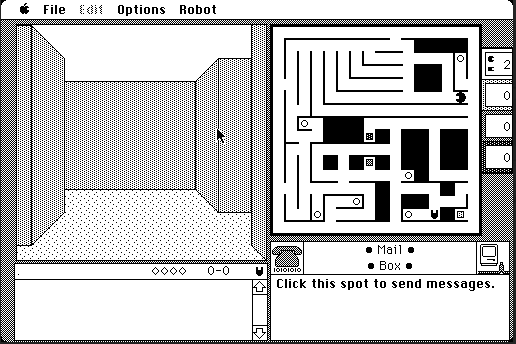
Maze Wars +
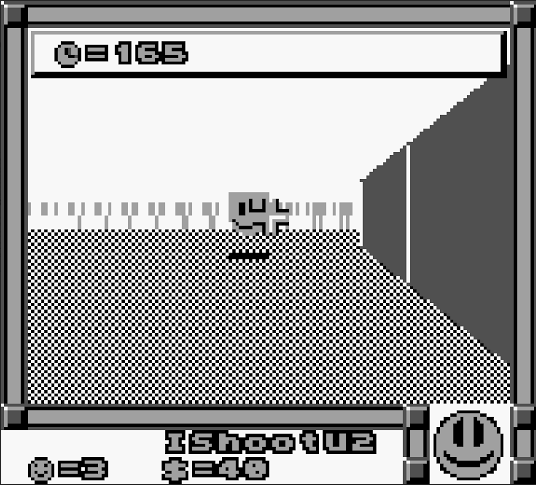
Faceball 2000
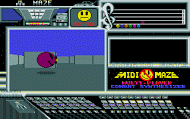
MIDI Maze
Prehistoric times
In the beginning was the Maze . The first version of the Maze was programmed on the Imlac PDS-4 minicomputer in 1973 and was later converted to different cars of the 80s and early 90s under various name choices - Maze War , Maze Wars + , Super Maze Wars (the version I played played on Mac), Bus'd Out , Faceball 2000 and MIDI Maze . It was a three-dimensional maze game for two players, written by three schoolchildren - Greg Thompson, Steve Colley and Howard Palmer. They completed their future masterpiece during their work and training program at the Ames NASA Research Center. Thompson and co-founder of Infocom (the company that developed text adventure games) Dave Lebling continued their work at MIT the following year.
They gradually added new features, and soon the Maze became what we now call first-person shooters. In addition to shooting at each other, players could look around the corner and check their location in the maze using a map. Opponents, depending on the distance, became larger or smaller. But the most interesting thing is that other people could watch the eight-player battle unfolding on the Sutherland LDS-1 computer with a graphic display - one of the first instances of gaming as a sport with the audience.
In Maze, they played over the network (via the PDP-10 mainframe) at MIT, and via ARPANET (an early version of the Internet) - between MTI and Stanford. There was a legend that the game became so popular that it was banned from ARPANET, because it transmitted too much data.
Jim Bowery Spasim , a 3D network first-person space shooter for 32 players — a sort of precursor to the Star Wars: X-Wing and Elite space combat simulators — was first released on the PLATO computer around the same time, making Maze and Spasim the progenitors of the FPS genre. However, they were not the only games before id Software with first-person shooting in real time.
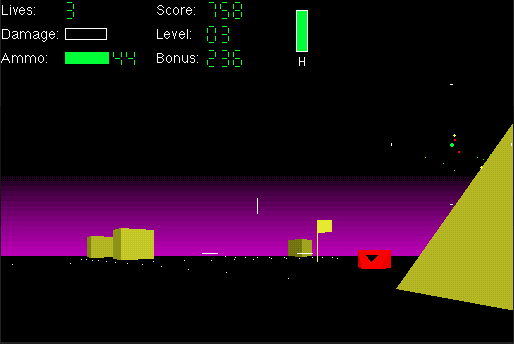
Specter

The colony
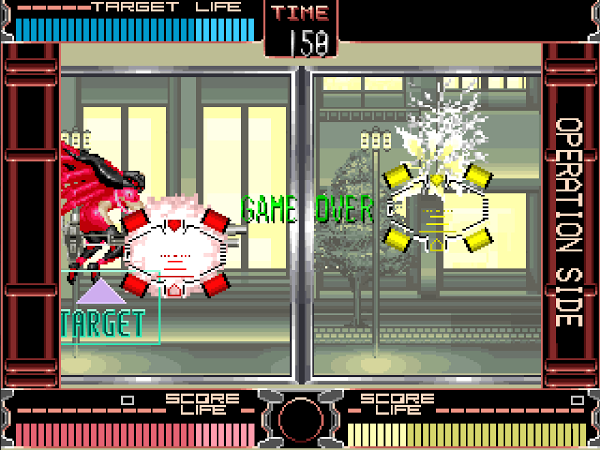
Gun buster
In 1980, the pseudo-three-dimensional tank first-person shooter Battlezone was released with frame vector graphics, which not only gave it a fresh and original appearance, but was also very fast. In the 80s and early 90s, Battlezone was cloned onto all platforms known to mankind, but among these clones deserve special mention Specter (1991) - an online game for Macintosh, in which players had to capture flags as quickly as possible, driving around the abstract futuristic landscape and shooting enemy tanks (and at higher levels, running away from them).
Another important progenitor of the FPS genre: The Colony (1988) was released on Mac. Half puzzle horror, half shooter, The Colony was a terrible game - the user could die in many ways without any warnings or explanations, even in the supposed “safe” first part of the game (after which it became even more violent to the player). But from a technical point of view, The Colony was quite remarkable. It created a huge, extensive, detailed underground black-and-white world in 3D, consisting mainly of frame forms. The graphics were rendered in real time, the player had the opportunity to turn his head by 256 discrete "degrees" (yes, using the mouse, many years before it became the standard). The Colony looked amazing and looked like a vision of the future. But her entire fame almost did not spread beyond the Macintosh environment.
The same unobtrusive as The Colony , and just as important was Gun Buster (1992) of Taito, the first (and one of the few) games with a light gun that came off the rail of rail shooters. Instead of controlling only shooting (as it usually happened), the game gave the user a joystick for moving forward / backward and strafe. Turns were tied to the sight of the light gun. The game had cooperative and competitive modes for one to four players, glass and graphics destroyed at the first level, unattainable for PC shooters even a few years later. Alas, the prevalence, and therefore the influence of the game, were limited only by arcade machines.

Wolfenstein
Mecha-hitler
Programming wizard John Carmack wanted to base bulky 3D movements of flight simulators and give them the speed available only for arcade games. He faced only one problem: home computers of the time - in 1990 - were slow. To create a fast three-dimensional action from the first person, he had to go on tricks. He decided to use a technique called “raycasting”, in which invisible rays were emitted from the player’s position in the direction of his gaze, after which simple calculations were performed to determine the location and height of the walls.
Hovertank (1991) was not the most impressive game, with ugly solid walls and black ceiling. Gray floors combined with monotonous shooting and boring enemies. However, a start was made.
Soon, Carmack polished his ray-tracing engine and developed a system that allowed textures to be applied to walls. He came up with this system when he heard about a 3D engine for a role-playing first-person RPG game Ultima Underworld . However, unlike Underworld , Catacomb 3-D (1991) could only apply textures to walls. The ceilings and floors were still one-color. Also in the game appeared a cartoon head showing the health of the main character, but the game itself had too many graphic limitations (except for the 3D engine) and did not make a strong impression.
But a completely different fate awaited the next attempt id - Wolfenstein 3D (1992). Finally, id found herself. Carmack came up with a couple of tricks to speed up the rendering engine, designers John Romero and Tom Hall created labyrinth-like levels filled with a bunch of secret rooms, and artist Adrian Carmack drew 256-colored objects and characters manually — a big step forward compared to the previous 16-color ones. games in EGA format.
However, Wolfenstein 3D owes its popularity not only to technical merit. An episode shooter that spreads through the shareware model, abandoned the fantasy style of Catacomb in favor of the good old assassination of the Nazis. A simple but funny story about William “BJ” spy Blaskowice, who decided to deal with the Nazi regime alone (as well as his secret army of zombie mutants), became a good bait for the players.
Rumors quickly spread not only that Wolfenstein 3D is full of excellent Easter eggs and hidden rooms, but that in the third episode Hitler himself could be killed. Or, more precisely, the Fur-Hitler - a mad tyrant saddled a huge robot with four machine guns and an eerie ability to always look exactly at the player. If you managed to kill him, then he did not just fall silently, but scattered into a huge pile of blood and guts.
This commitment to excessive graphic violence many times during the 90s put id into a difficult position - in particular, the company had problems with the censorship of Germany and the strict policy of Nintendo about the lack of blood on Super Nintendo. The game developer also felt pressure from religious groups, and then, on the wave of shooting at the Columbine school in 1999, and from a wide audience. However, this work was critically important to create a sharp, rough, arcade style that allowed id to conquer world domination. The rest of the developers could only catch up.
Seven survived, the rest in the ground
In her third game, an unknown Macintosh development company called Bungie wanted to combine Wolfenstein 3D -style dungeon research with first-person shooting. Pathways into Darkness (1993) was a claustrophobic and frightening first-person adventure in the entourage of catacombs near the Mayan pyramids. The game looked strange: the action itself takes place in a separate window from the indicator of life, equipment and goals, as well as the magazine of messages in the style of text adventure. (You can move these windows like normal application windows.)
Pathways was remarkable not only because of its outlandish multi-window interface and not only because it was the first Bungie experiment in the genre, but also how important the plot was to the gameplay. Where id simplified everything - there are bad guys who need to be killed - Pathways into Darkness was not so simple. Going deeper into the corridors of the pyramid, you stumble upon the corpses of your comrades, various treasure hunters and Nazis who perished in horror a decade ago. Special crystals allow you to communicate with them, uncover their lies and get acquainted with the fears that drove the Nazis crazy. Step by step, you are approaching the solution of the dangerous secret of the pyramid.
Bungie was not the only studio trying to take advantage of the success of Wolfenstein 3D . In early 1993, Epic MegaGames released Ken's Labyrinth with interactive slot machines needed to avoid Wolfenstein 3D cloning charges, 3DO Company developed the frightening, but inconvenient, management Escape from Monster Manor , and Bethesda released the quality Wolfenstein 3D clone in the universe of Terminator . Friends of id, the company Raven Software (whose office at that time was on the same street), licensed the updated, but slower version of the Wolf3D engine (now with sloping floors, texture floors and ceilings, jumps and the possibility of swimming) for its fantasy shooter Shadowcaster 1993 of the year. But all these competitors were destroyed by the next project id.
DOS is much worse
Endless fashion on the main characters of the space paratroopers began with Doom . The main work id Software, first released as shareware in December 1993, replaced the Nazi zombies with Martian demons. The game had a plot, but no one remembered it - everyone even called the main character “Doomguy”.
For the Doom id engine again decided to prefer speed over features. To create improved graphics with motion that became even faster and smoother than in Wolfenstein 3D , Carmack made the floors and ceilings even planes, and the walls - with vertical columns with superimposed textures. This meant that the player could not raise and lower his head, and in the geometry of the level there were no slopes and curves. But all this was not important.
Doom was full of surprises — monsters in the elevator, acid pools, suddenly disappearing walls (behind which hordes of horrific demons often hide), various lighting that always seems to hide something in the dark, and frightening sounds made by low-quality PC sound cards. Even the levels of difficulty made you think - the most average was called “Hurt me.”
Noticing that modifications made to Wolfenstein by 3D players extended the lifespan of the game, id made a lot of effort to make Doom modding easier. All graphic resources, sounds, and level design were stored in a WAD file (“Where's All the Data?”) Separate from the engine, so they could be replaced without any hacking. Thanks to modding, as well as the multiplayer game mode on the local network and the Internet, Doom life has been extended for many years.
The impact of Doom turned out to be shocking and instant. The speed and bloodyness of the game scared many people away, but most were so excited about the gameplay that they wanted an extra. The first-person shooters that came out earlier were no match for what effect Doom had. Almost in one day, the entire game industry has changed. Everyone knew about Doom , even those who had never played this game. On home systems, 2D platformers and graphic adventure games were no longer the dominant genres. Quick and bloody first-person shooters climbed to the top.
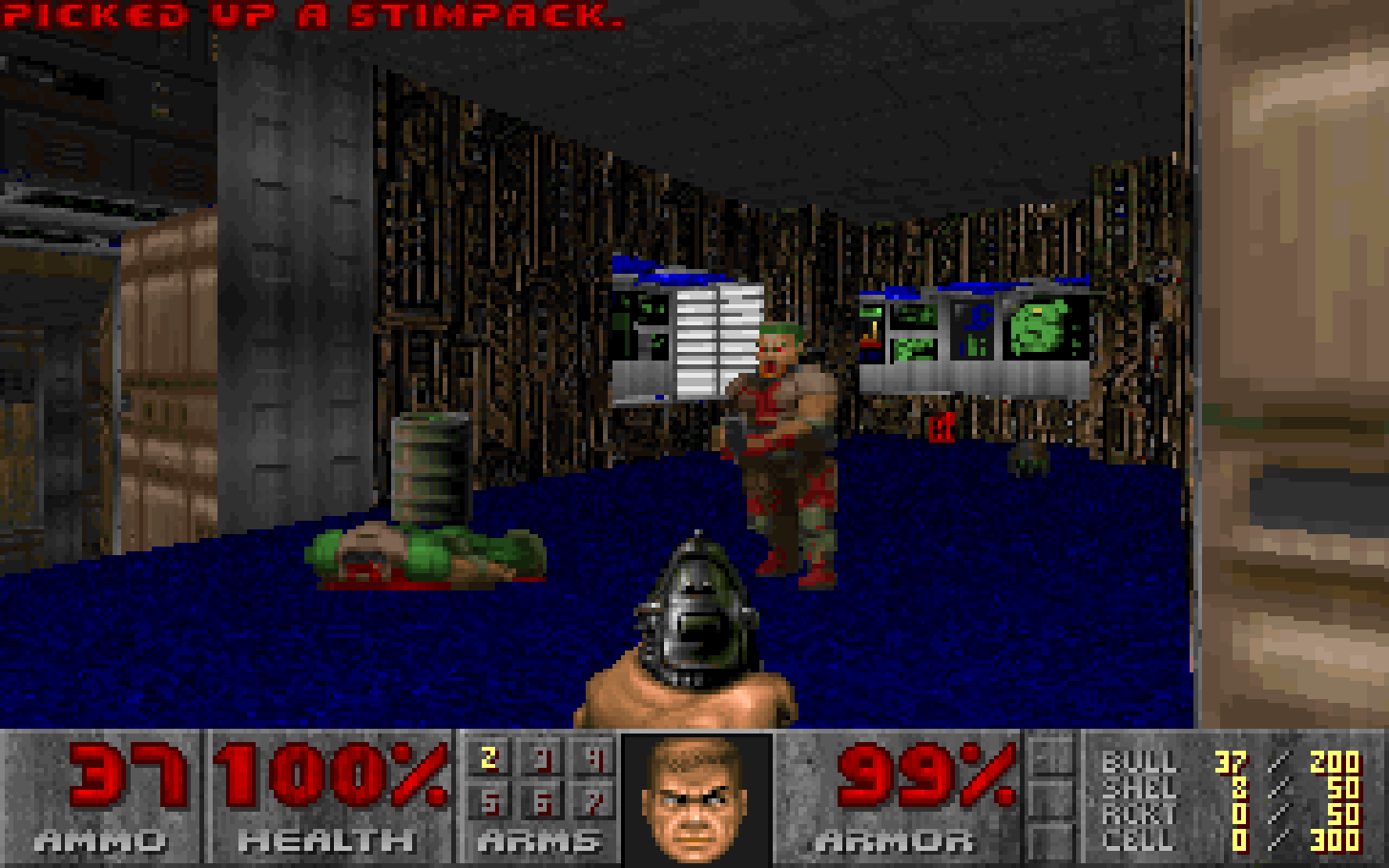
The one who changed everything - Doom
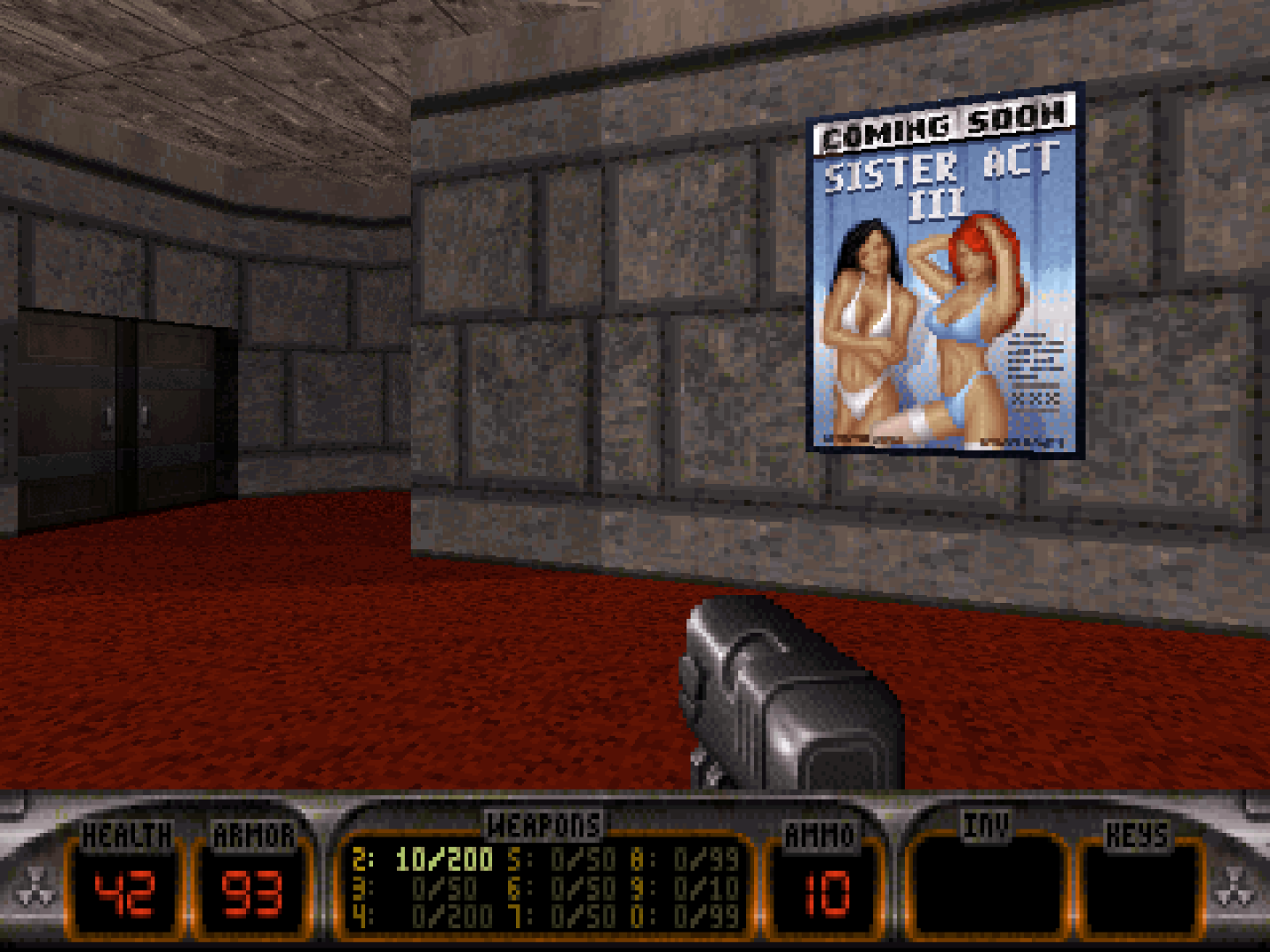
And one more game that was played by many, became a significant relic of that era - Duke Nukem 3D
Shake it baby
Not finding a suitable term for an emerging new genre at first, critics and fans called the shooters released in the next few years “ Doom clones”. Of course, many of them were more than clones, so it cannot be said that the game had no competitors. Good projects include the fantasy shooters Heretic (1994) and Hexen: Beyond Heretic (1995) by Raven Software, created on the Doom engine, as well as exclusive to Atari Jaguar Alien vs Predator (1994) from Rebellion and exclusive to the Amiga Alien Breed 3D (1995) Studio Team17 (famous for its Worms ).
Of all the doom imitators of the mid-90s, Duke Nukem 3D (1996) by 3D Realms was probably the most famous. The main character, foul-mouthed and overly sexist macho, kept his way through the strip clubs of Los Angeles, the scenery of films and other close to reality places, saving beauties and fighting police mutant pigs and aliens. By modern standards, the game was terribly sexist, but the players adored Duke Nukem 3D's perilous humor, and critics spoke well of the consumer future of the near future imprinted in the game, combined with bold references to the heroes of Hollywood action movies. (You can remember the time when Arnold Schwarzenegger, Sylvester Stallone, and Jean-Claude Van Damme were mega-stars.)
However, the game was remarkable not only for its perverted plot and proximity to the real situation. Duke was a real character with a bright personality. He not only gave out dozens of "cool" phrases and threats, but also quoted films like Apocalypse Now .
Duke 3D levels were filled with references to films supporting such phrases. In addition, it was one of the first shooters in which a lot of interactive elements unimportant for the gameplay appeared - light switches, dancing strippers, toilets and much more. Most of these objects either added Duke energy, or gave a sense of vastness to nonlinear levels.

Marathon
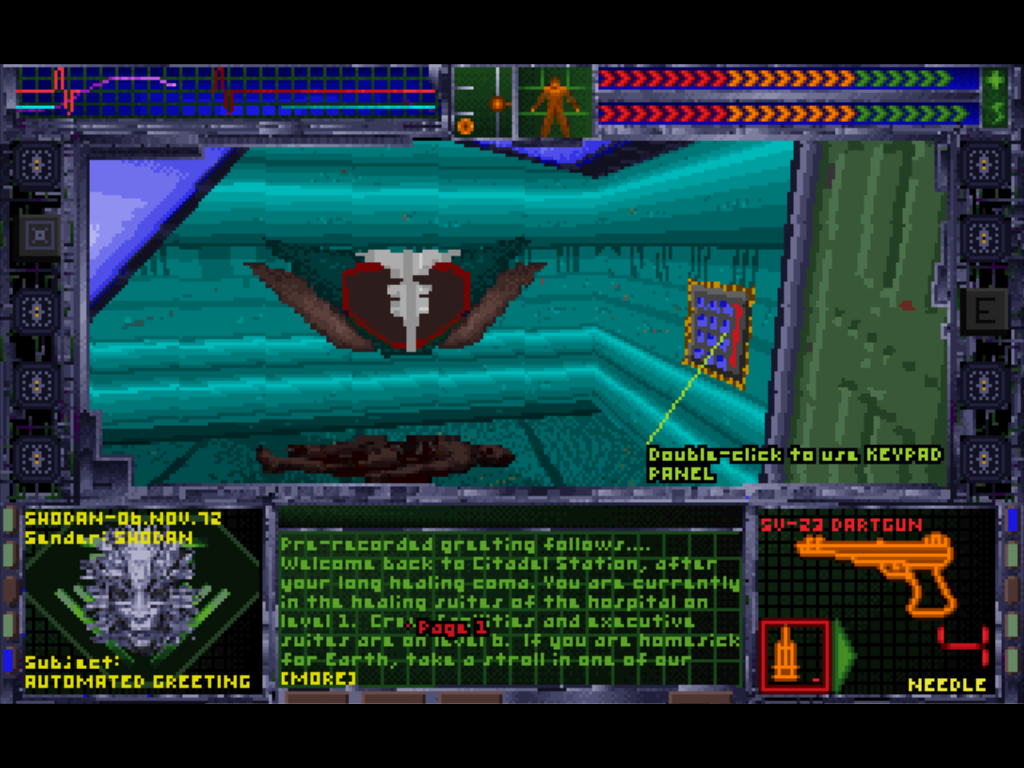
System shock
Speak to the terminal, because the AI can't hear you
One of the best obvious Doom clones turned out to be one of the least popular. Bungie’s Marathon (1994) was an undeniable hit on the Macintosh market, but remained almost unnoticed on the radar of most PC players until years later Halo came out.
The two most important contributions to the Marathon genre (apart from the fact that the game was the preparation for the creation of Halo for Bungie) were its plot and atmosphere. The plot would never have won the Pulitzer Prize, but it contained depth and complexity that was rarely seen outside the RPG and adventure genres, and therefore completely absent from the FPS genre. The game develops in the future, after 800 years, when the survivor of the crash, the main character tries to protect the ship of the colonists from the hostile aliens. An interesting twist was that of the three modules of artificial intelligence of the ship, one was destroyed in the first alien attack, while the others were seriously damaged. Worse, one of the damaged AIs went crazy.
Players could have a story to write a separate story through the terminals at each level. Many terminals gave access to crew logs, maintenance documents, messages, instructions, and other information that is out of order. The plot was so interesting that fans spent twenty years researching, transcribing and translating the printouts of terminal texts from Marathon and its two sequels, Durandal and Infinity . The whole trilogy remains an example of a stunning study of various deeply philosophical and technical issues about self-aware super-intellectual AI.
An important element of this first game was the atmosphere. Where Doom created tension with its tremendous speed and scatters of enemies flying in all directions, Marathon created its tension almost like a thriller. The levels were usually dark, with a mixture of claustrophobic, meandering corridors and cave-like rooms. The player never knew what was lurking around the corner - a room filled with enemies, a computer terminal, and maybe ready to scare an invisible alien to death (S'pht). In all three games there were a lot of scary moments, but the dark and gloomy of the very first of them, combined with the sudden attacks of S'pht, caused the most nightmares.
Marathon is also notable for being the first FPS since The Colony with mouselook - now a standard feature that allows you to freely rotate the camera with the mouse. In addition, there were weapons in two hands, real-time voice chat (in multiplayer mode), a simple physics engine providing different levels of gravity, official modding tools and automatic map drawing (the player could move in top-view map mode ).
The impact of the Marathon series was not as noticeable as the effect of another FPS with a serious storyline released in 1994 (just a week before Doom II ). Looking Glass of System Looking Shock , which can be briefly described as an FPS / RPG hybrid, evolutionarily more associated with Ultima Underworld than with Doom , did not sell well and did not even compensate for the costs. However, its release has caused a strong effect in the gaming industry and echoes that have been preserved for a long time. Her ideas broke out into the open world, and a team of excellent designers later took key roles in such important development companies as Irrational, Arkane, Ion Storm, Valve and Westwood.
System Shock and its 1999 sequel replaced the sharp tempo of Marathon and Doom with a cumbersome interface and control system that used almost all the keyboard keys. However, behind the sophisticated control scheme, many ideas remained that remained important features of the FPS genre - the story was revealed through audio recordings of magazines scattered around the world, the all-seeing AI opponent SHODAN constantly made fun of the player, the character could be improved to unlock new skills or special forces, strange hacker mini games, and sometimes graffiti related to the plot were painted on the walls.
Nevertheless, the greatest legacy of System Shock was the idea that shooters may not be just mindless "shooters." The plot flirted with philosophy, cybernetics, ideas of hostile AI and the very nature of humanity, and was a hint that violent games in the future will be able to say something meaningful.

Doom II, as complex as its predecessor

But no one complained that bloodlines are monotonous.
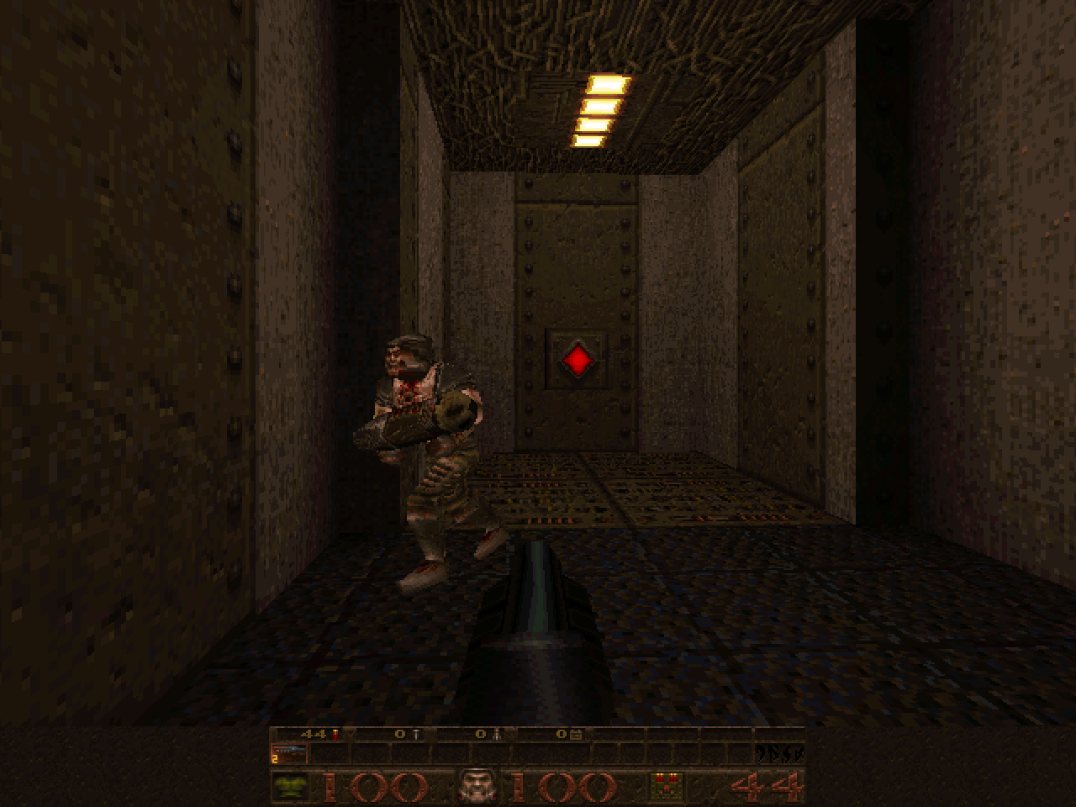
New Challenger - Quake
Super Impact Solvers
But this future has not yet come. Still controlled by the coding genius of John Carmack, id Software didn’t seem to pay attention to what was happening in the genre. Half the fun of playing first-person shooter at this stage in the development of the genre was to admire graphics, high frame rates, geometry and other technical characteristics. And from the point of view of technology, nobody could catch up with id.
Doom II (1994) made some improvements to the original Doom engine and added new levels to it, but Quake (1996) introduced a completely new engine that perfectly demonstrated the vast gothic world and the monsters of the game. Quake has become a huge technological leap. Instead of pre-rendered illumination and sprites of enemies and objects, dynamic real-time lighting appeared in it (light levels changed from dark to very dark) and polygonal models - for the first time in the genre (except for Descent ). The “boxed” level design is a thing of the past - Quake has a lot of curves, stairs and slopes. The player could lift his head up to watch the purple sky, or look down to view the ugly textures of water and lava.
In addition, Quake added jumps and swimming, now with dizzying speed at which id specialized, and support for 3D accelerators, which at the time were new technology. In addition, Quake made mouselook the standard of the genre. Quake's
technical advances could not hide the fact that, from a design point of view, the game was rather erratic (although I personally forgave her eclectic mix of styles, because there were nails and Thunderbolt shooting lightning bolts in it). Id co-founders John Romero and John Carmack were constantly in conflict with the design decisions of the project, and in the later stages of production the theme of the game changed from medieval fantasy to science fiction. Quakeit looked awesome, it was interesting to explore the back streets of the levels, but the single-user mode quickly exhausted itself - few had completed the game to the end.
Quake was the first shooter that was actively played on the Internet and in tournaments. It is worth noting that I mean relative activity - at that time there were thousands, perhaps tens of thousands of people all over the world, and not millions, like today. Then they did not come up with the selection of opponents under the player level (matchmaking), he simply chose a server (or created his own) and joined the game. Most players had dial-up access at terrible speeds, so you’ve got a huge advantage if you have cable Internet or a T1 channel.
First, deathmatch became the most popular mode, the battle of all against all, the goal of which is to kill more players than everyone else (if you die, then respawn in a few seconds, losing all armor and collected weapons). However, the game was very easy to modify, so many players were more attracted to other multiplayer modes, for example, a command mod with flag capture and Team Fortress fighter classes , the creators of which were later hired by the developer of the Half-Life Valve.

Goldeneye

Very familiar levels for those who are now about thirty.

Perfect dark

“Do what I say. I sent two pistols about you. ”
License to kill
Gaming consoles at first hardly coped with the requirements of first-person shooters. The problem was not the power of the graphics or processor - the main obstacle was management. The best FPS were developed taking into account keyboard controls, and more and more games were counting on a combination of mouse and keyboard. Console controllers simply could not achieve the desired accuracy and complexity.
But two games on the Nintendo 64 - Goldeneye 007 and Perfect Dark - proved that this is possible. Both were created by the British studio Rare, previously known from the Battletoads and Donkey Kong Country series . From Goldeneye 007 released in August 1997they had few hopes, but she was a huge success. Its single-user mode allows you to feel like James Bond, and it was not some cheap imitation. Multiplayer mode was so good that it changed the direction of development of the FPS genre, and in general games on consoles.
The best way to play Goldeneye was that four friends sat next to the TV, each looking at their own small quarter of the screen (most people did not have 55-inch monsters dominating the current market; the usual 1997 TV had a diagonal of 20-25 inches , sometimes less, and an aspect ratio of 4: 3). A scam with peeping at someone else's part of the screen was considered unacceptable. (A small percentage of players even struggled with on-screen cheating, putting cardboard dividers on the TV.)
Having borrowed the idea of a different reaction of the characters to shots to different parts of the body from the arcade light shooter Virtua Cop , Goldeneye implemented damage modeling depending on the point of impact. If you shoot someone in the leg, he will start jumping and walking with difficulty, if you shoot him in the head, he will instantly die; shoot him in the groin to double his torment. Shot in the groin was the maximum level of humiliation in multiplayer mode, surpassing even the occasional suicide mine with a remote control.
Other features of the multiplayer mode are shots in the toilets on the Facility map, killing opponents through the grating on the floor, setting boo-boo traps and throwing knives. Looking back, it’s hard to understand how many of us managed to use the strange C keys of the Nintendo 64 controller to control the camera, straighten left and right with the side keys and aim with an analog stick (someone found the option to control two controllers ).
After Goldeneye Rare released Perfect Dark , a science fiction FPS with a woman in the lead role - only the third game of the genre decided on this, after Rise of the Triad (in which you could choose different male and female characters) andJurassic Park: Trespasser (a game famous for having to look at your character’s chest to check your health).
Despite the weak influence on the genre, Perfect Dark has become an excellent Rare shooter. She had better, more stylish and beautiful graphics, smarter opponents and much more options for multiplayer modes. The whole game was full of ideas and variations. Each difficulty level had its own set of problems - in more complex modes the player had more tasks; the game did not just increase the energy and number of enemies.
But Perfect Darkfell victim to its own ambitions and the era of Nintendo 64. It demanded too much from the console, which led to a low and torn frame rate. And it came out at a time when most console players were leaning toward the new PlayStation 2 and GameCube systems (and only a few enjoyed the short life of the Sega Dreamcast).

If you can't miss the cutscene, then you won't miss it.

Half-Life was amazingly innovative, but it spawned a bunch of bad clones.
Silent protagonist
Suddenly, a newcomer Valve licensed and modified the Quake engine for his little-anticipated, but changing, genre debut game. Half-Life , released for the PC in November 1998, introduced the world to the bearded, silent theoretical physicist Gordon Freeman and the Black Mesa military complex. It seemed that this world without any limits passes through underground laboratories, above-ground utilizing installations and rooms for rest. The sense of the integrity of the world was intensified by a five-minute monopole ride through the very heart of the complex.
The player never lost control of Dr. Freeman. There was not a single rendered scene in the game in which Gordon would act independently of you, and not a single dialogue from which you could not run away to go about your business.
The plot slowly developed, transmitted through the environment and actions (and not words) of aliens, soldiers and your colleagues. It featured great action scenes, such as skirmishes with hostile aliens and soldiers, quiet moments of contemplative research and intense episodes of secretive movement next to blind tentacles reacting to sound. It all seemed awesome.
Unfortunately, Half-Life suffered from what I call the Myst effect.". It was a revolutionary project for the genre, but many developers failed to understand what made it so great. Poor quality shooters after Half-Life were filled with linear corridors and poorly set scenes that bored the players. The same was true of most good clones. Labyrinth-like, non-linear designs of levels of early shooters like Doom and Marathon died after the success of Half-Life , followed by the standard motivation “I am a good guy and kill the bad ones”.

Unreal

Unreal Tournament

A summary of the gameplay Unreal Tournament .

Quake III

Quake III
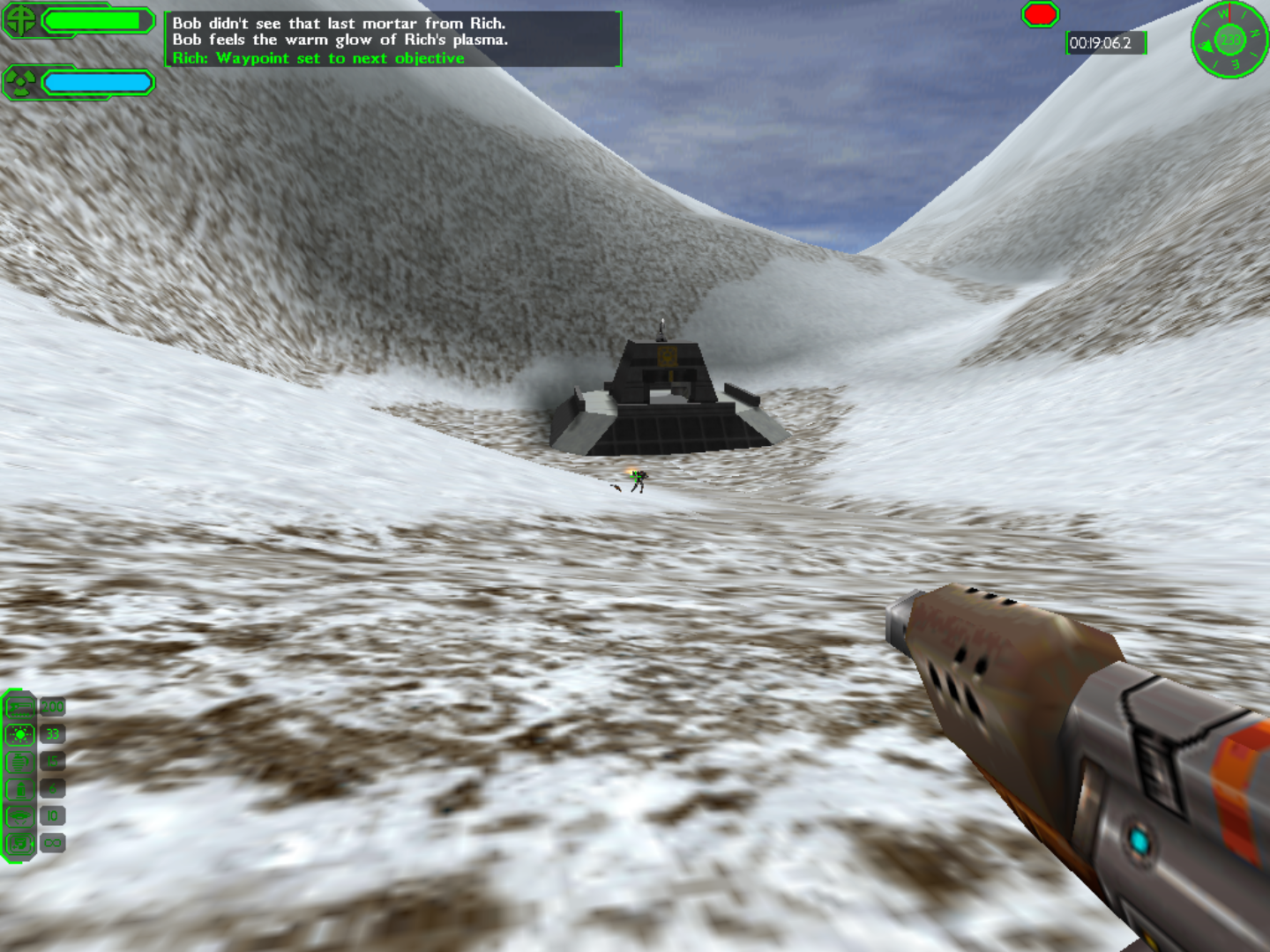
Tribes
Rocket jumps
However, the throne of the lord first-person shooter has not yet captured Valve. In April 1998, a new challenger appeared in the arena - Epic with the Unreal game , in which amazing graphics combined with a hostile alien world, a melancholic story of a lost paradise and an unusual set of weapons. The sequel to the 1999 Unreal Tournament strengthened Epic's position in the FPS genre thanks to the beloved and long-lived multiplayer mode, which was surprisingly interesting even with AI-controlled opponents.
Dynamix also attempted to capture the crown using the first part of the Tribes "world's fastest shooter" (which was then an offshoot of the Earthsiege). Exclusively multiplayer Starsiege: Tribes (1998) shook a masterful performance. Its huge open spaces could be crossed in seconds, not in minutes, thanks to a physical bug known as “skiing”: constant jumps when descending a hill did not allow the friction force to act on the fur, allowing it to accelerate to infinity.
Despite the loss of two key designers, Tom Hall and John Romero, who left to create the thundering but weak Daikatana (2000), id still had a couple of tricks to spare. Quake II (1997) sometimes looked like a bright version of its predecessor and served as a transitional stage between it and Quake III: Arena (1999). LikeUnreal Tournament , Quake III focused on creating open spaces in which players could tear each other apart.
The best players in all three projects achieved victory in quite ... unusual ways. I already mentioned how it was possible to cross the entire map in a matter of seconds in Tribes , but in Quake III and Unreal Tournament we had our own maneuvering victory over gravity. You would not be able to win in Quake IIIwithout mastering the rocket jump and plasma jump: immediately after the jump, the player fired at his feet (with a rocket launcher or plasma gun) to take off higher. (There was also plasma climbing - the principle is the same, only shots were made at a certain angle and next to the wall.) And every serious player in the Unreal Tournament had to know how jumps and telefrags affect: as soon as you teleport to a place where someone is dying.
All three games had three-dimensional maps filled with fierce battles. Now players could look for opponents. But times have changed, and the genre has moved in a new direction - less arcade and more realistic. The new FPS growth required fewer skills from the players and was deployed on simpler maps.
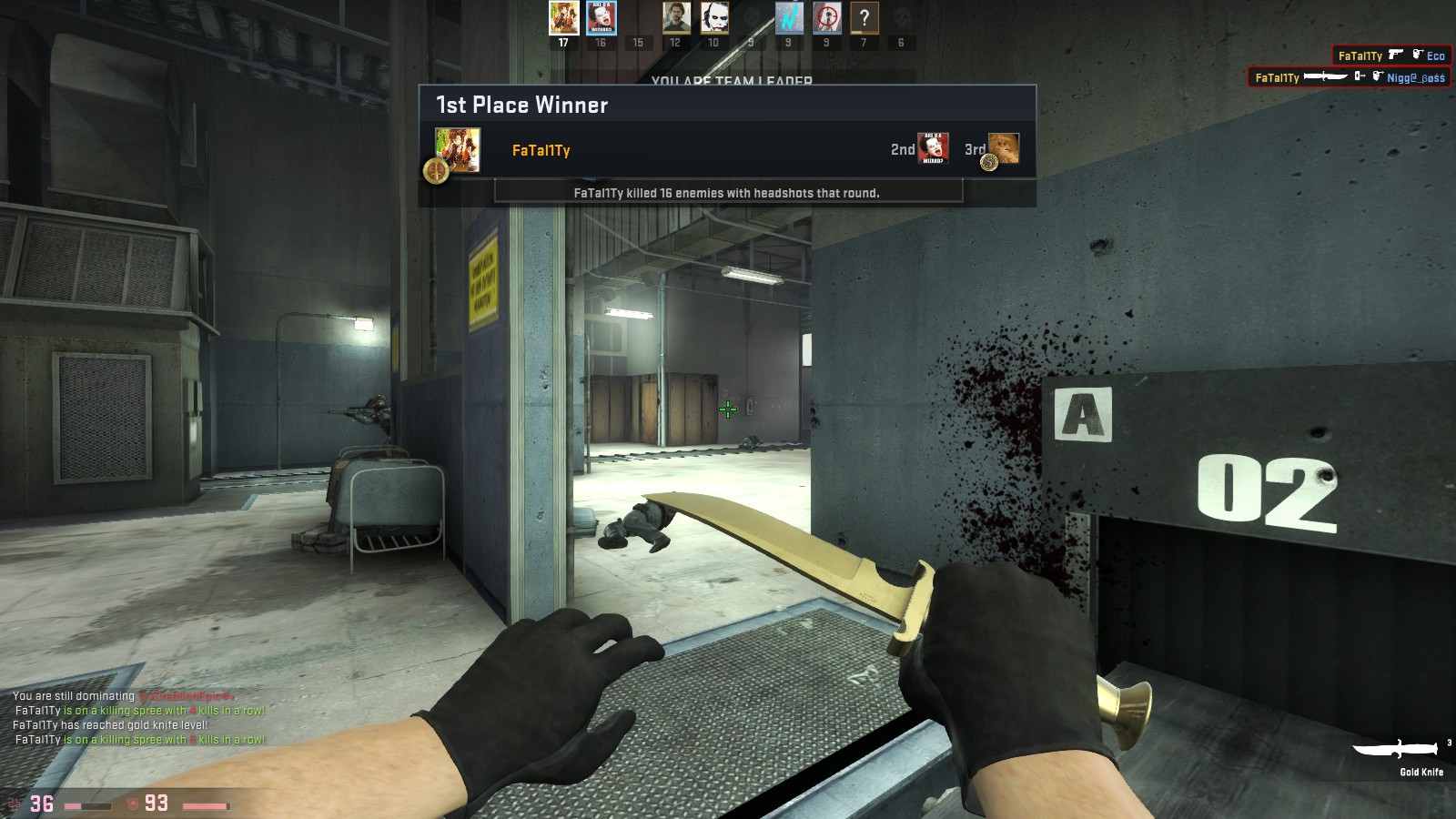
Counter strike
Terrorists win
Many mods used to come out, and many of them became popular, for example, the original Team Fortress , which was a Quake mod, or Justin Fisher’s total Doom conversion in the Aliens universe, which some considered better than Doom II . But no mod by its influence can match the Counter-Strike . He surpassed the popularity of the game on which he was based (and resulted in a separate commercial product). Of course, Half-Life set the tone and plot for single-player campaigns, which began to copy all first-person shooters. But shooters have always been more designed for a multiplayer game, and not for a single passage. Frags and secretive murders are always more interesting when you know that you beat a person, not a bot.
Counter-Strike is lucky. The growth of its popularity ideally coincided with the expansion of the base of Internet users, the increase in bandwidth, fatigue from Quake , the end of the golden era of PC games and the increased interest in competitive games. The similarities of Quake III and Unreal Tournament were certainly wonderful, but it was difficult for the viewers to understand them. Some gamers are tired of the chaotic detmatches “all against all”, in which the player won with the fastest reflexes and the best rocket jumps.
Half-Life made the transition to more serious characters and plot in single-player FPS. Counter-Strike also gave death at the hands of the enemy more significance. It was no longer just a number in the statistics — each death had its price. When you died, you could not respawn in a second, you had to wait until the next round. You had to wait and watch while teammates tracked down the remaining enemies.
Counter-Strike captured Internet cafes around the world and helped the emergence of special gaming LAN centers. And gradually, year after year, he pushed Quake and Unreal Tournament to the periphery of amateur and professional competitions. Competitions with serious budgets in the mid-2000s attracted international interest, and the best players earned hundreds of thousands of dollars in prize money, as well as support.
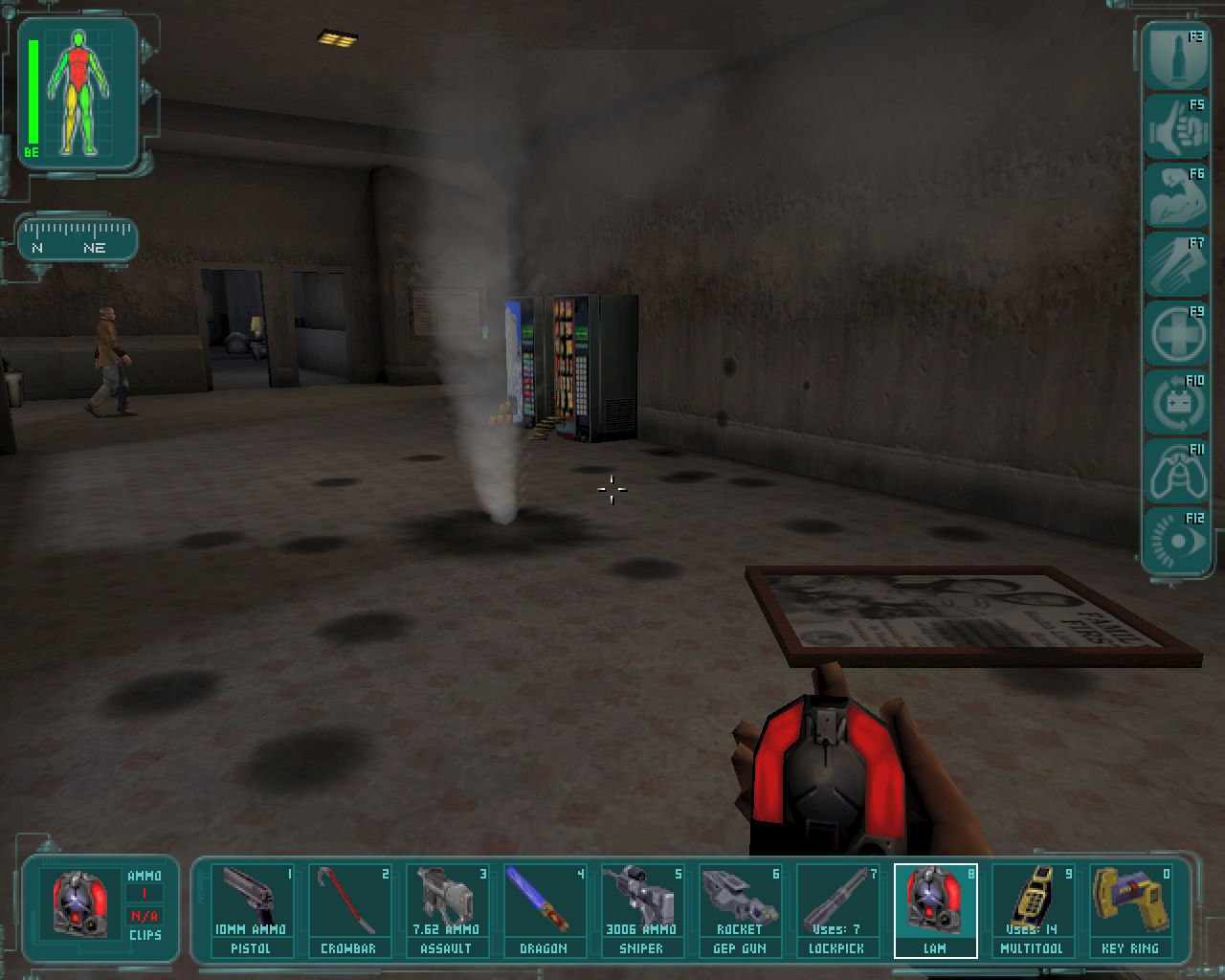
Deus ex
From the mines on the walls are excellent stairs.
In 1998, the developer of System Shock Looking Glass became even more distant from market trends, releasing Thief: The Dark Project , a medieval FPS with elements of stealth, which was positioned on the market as a "first-person stealth". Like the rest of the company's games, it became a hit, and smart enemies trying to escape from a wound and realistically reacting to sound and visual stimuli opened the door to further development of the design.
Many of the ideas and philosophical approaches have been preserved in Ion Storm's Deus Ex (2000), which has made stealth one of the many strategies for surviving in a chaotic and dangerous cyberpunk dystopian world. Deus Ex was not a simple shooter, but it could be played like a regular shooter, if you develop the appropriate characteristics of the character with the help of skill points.
Everything depended on the player. All puzzles and possible conflicts had several solutions, and most levels could be completed in different ways - this fact was confirmed by players who got into inaccessible areas, placing mines on the walls and climbing along them like on stairs.
No game before it seemed so free and real, despite its flaws. The graphics were bad even in those times, besides, Deus Ex had a dubious achievement - it began the sad tradition of mini-games with door-breaking and first-person hacking.
The Chronicles of Riddick: Escape from Butcher Bay (2004) and Dishonored (2012), among a few other games, continued the tradition of intellectual hybrids of first-person shooters with stealth / RPG elements (the last game gets extra points for not bothering player hacking locks).
Tom Clancy's Rainbow Six (1998) is also worth mentioning - this game and its sequels have implemented their own approach to the player's choice. These tactical first-person or third-person shooters were created with the support of the writer Tom Clancy, and keeping the style of his books, were not only authentic, but also realistic to the smallest detail. This made them extremely difficult - any shot could kill you, and the fallen comrades did not rise after the missions, which reduced the size of the squad.

Halo , you could hear about it.
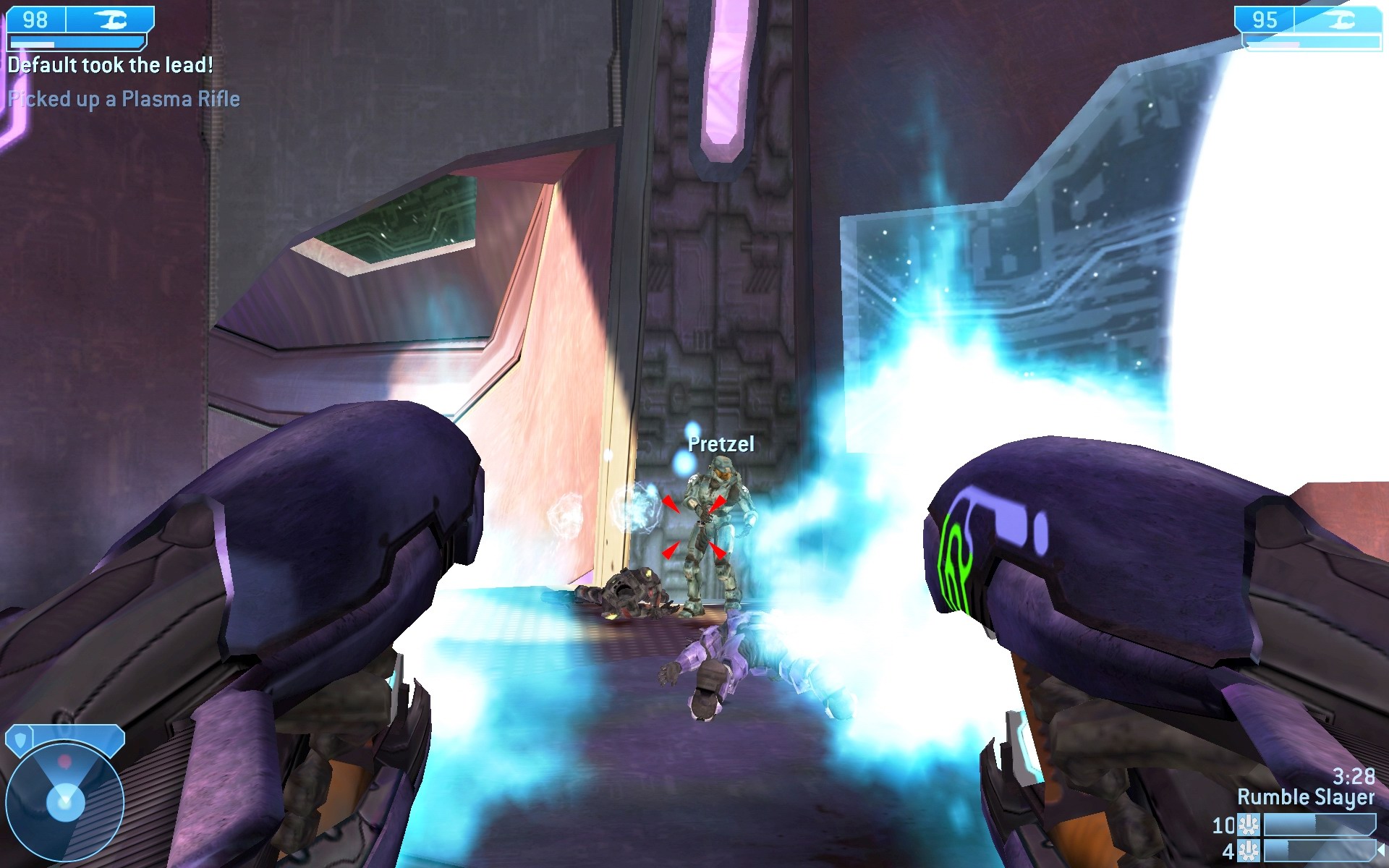
Or about Halo 2 (3, 4, 5, etc.)
Red vs blue
After completing the Marathon trilogy, Bungie turned to real-time strategy for several years, releasing the famous Myth series. Then in 1998, the studio began work on a third-person RTS / third-person shooter called Halo , which was publicly announced in 1999 at the Macworld Expo (one of the rare occasions when Apple talked about games at its main presentation).
Soon, Microsoft added Bungie to its growing game development department, and Halo broke away from the roots of the Mac to become Xbox exclusive (however, after a couple of years, ports under Mac and Windows appeared). The loss of Mac gamers has become a godsend for the rest of the world. Halo: Combat Evolved was transformed into a first-person shooter and a strong incentive to buy an Xbox - in fact, the only reason for acquiring a Microsoft console at that early stage of its development.
In Halo , there was little innovation, but she was remembered for her stars - super-soldier Master Chief and Cortana, intelligent AI, living in its neural interface. The game has paved a wide road to the rich storyline, torn apart by the war of aliens and humans. As in Marathon , the plot is closely related to the idea of aggressive AI and hostile aliens. (However, unlike Marathon , with each sequel, the plot became less interesting and more pompous.)
Halo was dizzyingly interesting, with an accessible, but deep battle strategy that often resulted in a duel of cats and mice. Each game in the series had its own peculiarity that other shooters could not recreate, and as the first Halo selling Xbox consoles, Halo 2 (2004) sold people the paid online service Xbox Live, and the multiplayer mode Halo 3 (2007) greatly influenced Xbox 360 image.
War never changes
It's amazing how fresh and delightful the WWII Medal of Honor shooter looked like after its release on the PlayStation in 1999, even with a lot of military FPS. A kind of spiritual follower of the movie saving Saving Private Ryan (so much so that the director of the film Steven Spielberg participated in writing the plot of the game), Medal of Honor takes the player out of the front line, so that in 1944 he would destroy Nazi fortifications and perform strategic tasks, trying not to be caught and killed
The gameplay was much more tactical and realistic than in normal FPS or wargame, with a convincing environment (relative to what the PS1 was capable of), high-quality sound and intelligent AI — enemy soldiers and patrol dogs reacted dynamically to the player’s actions.
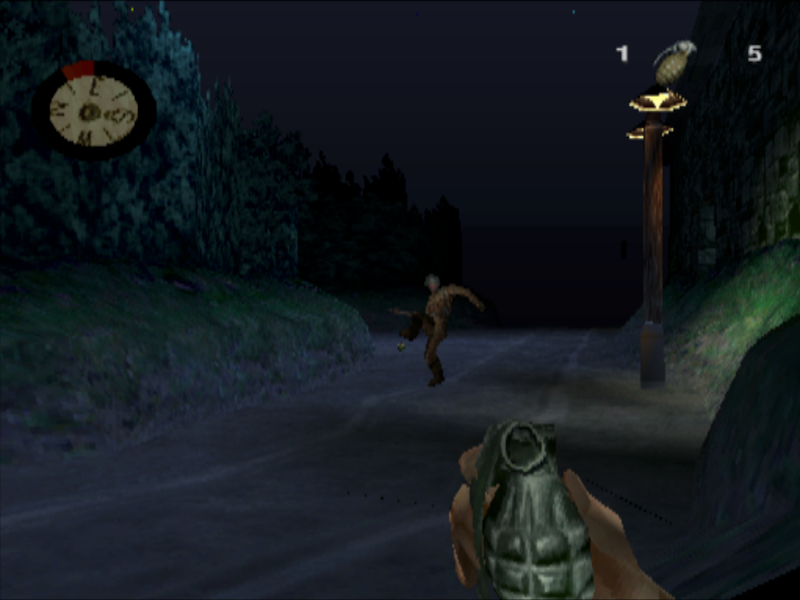
Medal of Honor as Spielberg script.

Battlefield 1942
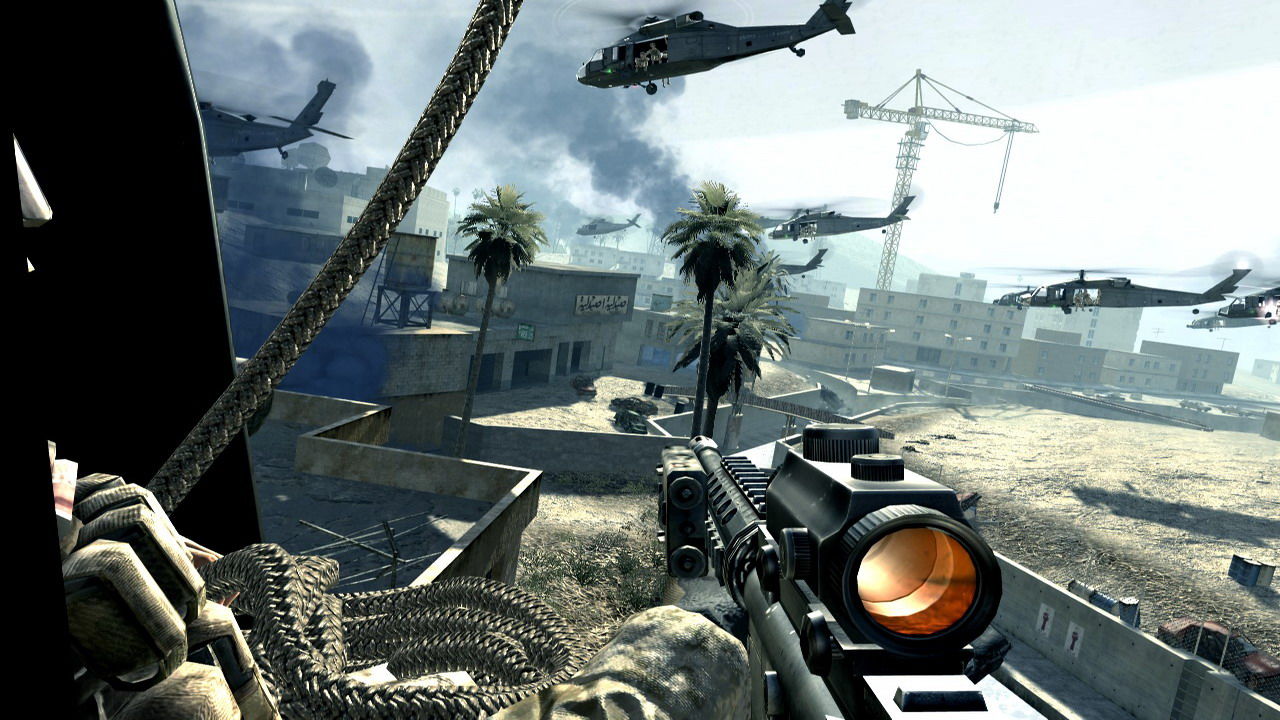
Call of Duty: Modern Warfare

They may look like copies of each other, but there is a reason why CoD games remain insanely popular.
A series of clones followed the Medal of Honor . Soldier of Fortune (2000) doubled the cinematic realism and cruelty (for most people at that time, too much, because the player could shoot limbs and torture enemies), changing the entourage to modern times. The America's Army (2002) was created by the US Army as a game masking tool for recruiting recruits. Battlefield 1942 (2002) also adhered to the subject of the Second World War, but a class system appeared in it that added depth to multiplayer battles. At the same time, the series of games of the current market leader Call of Duty (2003) was founded. The main difference from the Medal of Honor formula was the addition of a campaign for British and Soviet troops. Operation Flashpoint: Cold War Crisis (2001) decided on an even more realistic tactical simulation of battles (the excellent Arma series was created by the same developer and retains the legacy of OF).
Soon, Battlefield became one of the pillars of online multiplayer on the PC. Well-balanced battles with the class system rewarded all players - lovers of running and shooting, patient snipers, secretive scouts, pyromans, pilots (yes, there were a lot of vehicles in the game) and rescuer angels (medics).
Series Battlefield jumped in different time periods and styles of play. One of the most remarkable branches was the console Bad Company (2008), which resembled the video game version of the military comedy “Three Kings” . But the best part is the second one, which moved the action today and improved all the systems of the first Battlefield . It also added the class commander, who could (try) to give direct orders to his subordinates from afar, Battle Recorder, which allowed sharing with other special moments of the game years before the developers only thought about this option, and scalable maps that changed their size depending on the number of players.
While Battlefield actually owned the PC market, Call of Duty became the de facto standard of military shooters on consoles. As in the case of Battlefield , the most outstanding part was the one that abandoned the entourage of World War II in favor of modernity. Call of Duty 4: Modern Warfare (2007) was pretty sample, but that didn't mean anything. The game won many award-winning gaming media at the end of the year and sold seven million copies in just two months.
The Modern Warfare campaign was impressive. It was not a story about a man who alone saves all of humanity; Both the main characters and their comrades seemed to be ordinary mortals, vulnerable to the blows of fate. They were just soldiers - ordinary people with military training, fighting in battles started by others. The skill of Infinity Ward made it possible to emphasize how immoral their work could be. Most obviously, this was manifested in the prophetic scene of destruction observed through the thermal vision monitor.
While the game was followed by eight annually released sequels, each of which became louder, faster and less discriminating to shades than the previous ones. However, to this day, any Call of Duty game sells best, which is not included in the title of Grand Theft Auto or Minecraft .

Ah, City 17. (We all love Half-Life 2)
Source
While the military shooters climbed to the top of the sales of the genre, technical leaders Valve, Epic and id Software continued their three-sided battle. The competition between Quake and Unreal Tournament lasted until the mid-2000s, after which it fizzled out and continued only in the engine capabilities competitions (and everyone who watches the industry probably knows that Epic's Unreal Engine crushed idTech long ago, and id Software has not released nothing remarkable, except the corridor FPS with racing elements of Rage 2011).
Valve has established itself as the king of FPS — the prince of action-game engines — thanks to Half-Life 2 (2004) and two sequel episodes (released in 2006 and 2007). Half-Life 2 remains for many the best FPS due to its entourage - the City of 17, a post-apocalyptic dystopia created with attention to the smallest details, as well as a discreet presentation of the plot. As in its predecessor, the player could always control the main character, even when other characters started long dialogues. And if you somehow managed to remain indifferent to the plot and characters, then you could still enjoy using the gravitational cannon to throw various objects.

Crysis remains amazingly beautiful even ten years later.
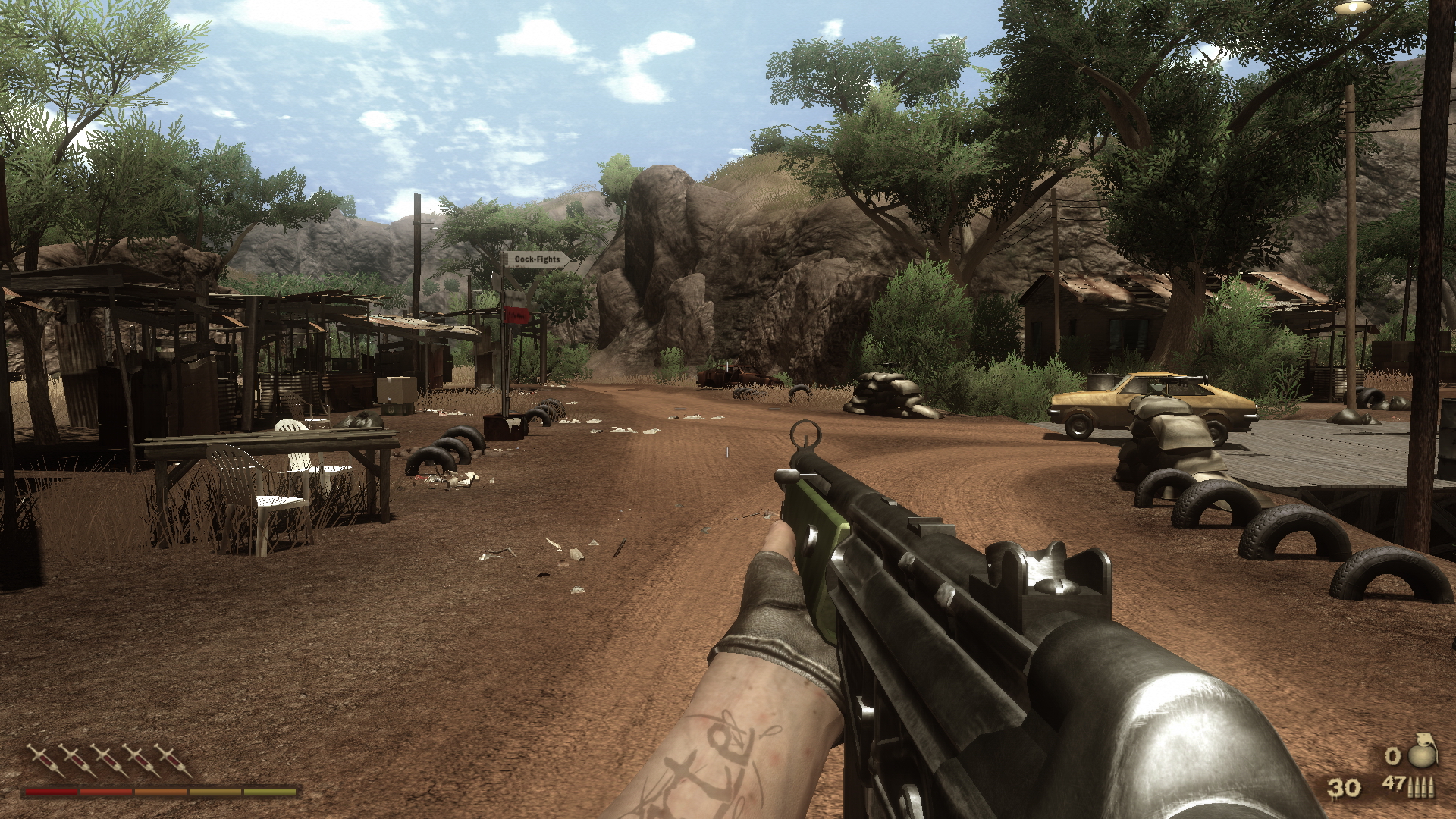
Far cry 2
Burning hills
Strange, but even eight years after the release of Crysis (2007) by Crytek, it was still a tool for evaluating PC performance. The game itself, like Far Cry (2004) before it, was a terrific journey through an overgrown jungle archipelago, notable for using the nanosuit, which made the player almost invisible, and performing tasks in a random order.
The dynamic approach to the battles in the jungle was better implemented in the Ubioft-developed Far Cry sequel in 2008, which sent the player to modern Central Africa. In Far Cry 2, the main character finds himself in the middle of a bloody civil war for diamonds, in which moral is relative. The game gives the user the only task: he needs to kill a gun dealer named "Jackal".
Smart AI games, hilly roads, strangely moving vehicles, immoral soldiers, surgical operations on their own bodies, gradually breaking weapons, ambushes on convoys, insane plot moves and grazing animals created one of the most convincing and fascinating open worlds.

FEAR
Acronyms are used.
First-person shooters have experimented with horror elements since the days of Doom , but FEAR (2005) went even further and connected the FPS with the supernatural. The game used all the tricks of a good psychological horror movie - creating atmosphere lighting, frightening sounds, terrifying opponents, excellent tactile sensations, long claustrophobic corridors and a creepy ghostly girl, constantly appearing unexpectedly.
Survival shooters in the open world could learn a lot from STALKER: Shadow of Chernobyl (2007), which immersed the player in the atmosphere of a very real destroyed Chernobyl zone and Pripyat. STALKER didn't need a horror story to scare you; he was terrified by his own threatening, gloomy world in which all the people around him were driven to despair, and every piece of the map — the abandoned building, the gangster camp, the abandoned footpath crowded with the mutant foot of the hill — seemed to have painful memories of the 1986 Chernobyl disaster. But most importantly - STALKER has become evidence that first-person shooters can be slow and contemplative, beautiful and subtlely frightening. This lesson can be learned by the developers of other games.
A comparison with Fallout and Borderlands may seem far-fetched, but the growing influence of Eastern European developers has shown that the approach to creating STALKER is successfully copied. So far, the closest to him was the Metro series of 4A Games, which began with Metro 2033 (2010). Less wild and more carefully crafted than STALKER , the games of the Metro series, however, captured the cruel and gloomy world after the nuclear apocalypse. It was interesting to watch the world with defective gas masks and improved bullets, until the player was bored with quick-time events and annoying monsters.

Mirror's Edge : beautiful parkour.
Unarmed
The extraordinary Portal (2007) from Valve was a huge surprise and addition to the Orange Box compilation that sold Half-Life 2: Episode Two and Team Fortress 2 . The game world was amazed and fascinated by the opportunity to get a cake by solving puzzles. All of them were connected with the use of the portal-creating cannon, which helps Chell's character to pass a sequence of rooms under close observation (turned out to be hostile) of the GLaDOS AI system - the only, with the exception of Chell, game character (unless you count the companion cube). In addition to successfully introducing innovations of the genre, Portal has become the progenitor of a new sub-genre first-person shooter with an abundance of puzzles. And at about the same time, the so-called “walking simulator” genre appeared (which is actually a research genre, and not a real walking simulator ) in the face of the mod for Half-Life 2 called Dear Esther .
The cult hit of DICE Mirror's Edge made the FPS genre, tired of shooting, move in a different direction. At a time when parkour was relatively new in 3D video games, the player could control courier Faith, jumping on the walls and roofs, avoiding the police and enemies who were constantly pursuing her. A unique minimalistic style of graphics that used mostly red and white colors helped to focus on a desperate escape to security. Based on the physical speed of Faith, players instinctively chose whether to continue to slide, roll and jump, or to stop and fight. Ironically, shooting was the worst part of the game; Fortunately, most of it could be passed unarmed.
Perhaps this was the influence of Metroid Prime (2002) - the renowned first-person adventure game for the GameCube downplayed the value of shooting and instead focused on research and fast acrobatic platforming. Be that as it may, Mirror's Edge has become a clear statement that the shooters do not necessarily need crowds of shot enemies, the main thing in this genre is speed.
Delight
Irrational took eight years to create a spiritual follower of System Shock 2 (EA owned the license, which was not interested in the sequel). After many changes in the plot and surroundings, the game turned into a criticism of Ayn Rand's objectivist philosophy using the example of a shattered dream of utopia called "Delight."
The breathtaking first level, on which we descended to a decaying city below the surface of the sea, set the stage for one of the most qualitative examples of the transmission of the plot through environments in the entire gaming industry. Unfortunately, the decision to “collect” ADAM’s little sisters (genetic material used to change DNA) was too binary to take into account all the dark nuances of their relationship with Big Daddy protecting them. Nevertheless, BioShock was another important step in creating a narrative based on the architecture and character design.
Three years later, a sequel appeared, which added more nuances and improved the integrity of the plot (at the cost of a number of outstanding moments), then in 2013 the BioShock Infinite prequel unsuccessfully solved the difficult task of completing the story. In addition, Infinite has completed the sad transition from RPG / shooter hybrid to standard FPS.

Left 4 Dead (hold on, Zoe).
Whatever you do, don't scare the Witch
With the exception of a series of arcade shooters with a light gun from The House of the Dead and sometimes surviving survival games, zombies were rare guests at the FPS until the release in 2008 of Left 4 Dead . In it, four players had to make their way through the many obstacles created by the invisible hand of an artificial intelligence algorithm called “Director”.
The “director” made the game easier when the players failed, and complicated it when everything went too smoothly. He placed opponents and items, controlled the mood of users with the help of music and visual effects. By “users,” I mean both individual players and the team as a whole.
Like Deus Ex with Far Cry 2 before her,Left 4 Dead succeeded in realizing the idea of spontaneous, or dynamic gameplay. She asked a simple question: you are in a zombie movie - how are you going to get out of it? The game did not have a plot, but small scenes arose during the game all the time - your comrades died around trying to bring your corpse back to life, or someone accidentally frightened the Witch, and everyone tried to escape from it.

Borderlands
Do you want to listen to the new dubstep that I came up with?
Immediately after the success of the additions to the Half-Life Opposing Force (1999) and Blue Shift (2001), as well as several Brothers in Arms shooters in the entourage of the second world war (the only one of which was the first one), Gearbox decided to create a shooter that could stand out from the crowd.
Borderlands(2009) abandoned the traditional hyper-realistic brown palette in favor of graphics with cel-shading technology, naked sectarians in gas masks, loot, huge alien insects, mutated dog lizards, and a huge dose of RPG mechanic that created an MMO sensation (even headshots were called “critical hits” "). A lot of things in the game did not work as they should, but the excellent graphic style and gameplay of “shoot and collect” appealed to the players. Perhaps due to the success of Borderlands and her sequels, absurdity began to return to the genre.

Hi, Destiny

In Modern Combat 5, you can play on mobile. Such graphics would not be allowed on most modern consoles.
Present and future first-person shooter
First-person shooters today are an interesting genre. His pillars Bungie and Respawn seek to supplement the console shooter with MMO elements and large-scale battles - in Destiny (2014) classes, loot and grind levels, constant additions of content and intense battles appeared. In Titanfall (2014), massive Titans participate in epic battles of furs. Nevertheless, it seems that both of them could not reach their full potential, and in the meantime, the new technology could force FPS to move in completely different directions.
Virtual reality has tremendous possibilities of immersion, but so far it is not very suitable for the genre, despite the free movement; At the same time, mobile devices and tablets are becoming quite possible alternative to consoles - more and more people are buying compatible external controllers. (And even without a gamepad, the best modern shooter for iOS Modern Combat 5 is quite playable and interesting.) The
new shake-up will be interesting. Most modern shooters that are not produced on an annual basis, like Call of Duty , are already over two years old. Tens of thousands of people still play Team Fortress 2 daily . Quake III: Arena still maintains an active community in the free Quake Live, and various similarities of Battlefield - at the moment this is Battlefield 4 (2013) and Counter-Strike : Global Offensive (2012) - are becoming the choice of the best players.
The genre has never been so diverse. It has fast and slow shooters based on tactics or reflexes, severely limited in capabilities and those in which you can do anything, shooters in arenas and huge planetary-scale monsters (anyone knows PlanetSide 2?) Some have a plot, the majority is missing. The genre continues to explore new ways to make shooting and running interesting. Other genres, such as RPGs in the open world and fast-growing MOBA, are threatening to take his crown from him, but after two decades of dominance, first-person shooters show no signs of fatigue.
All Articles